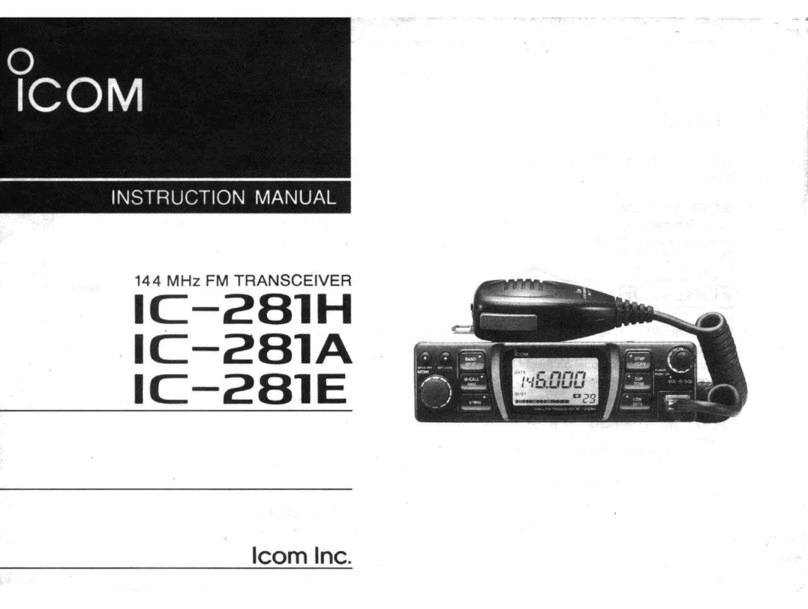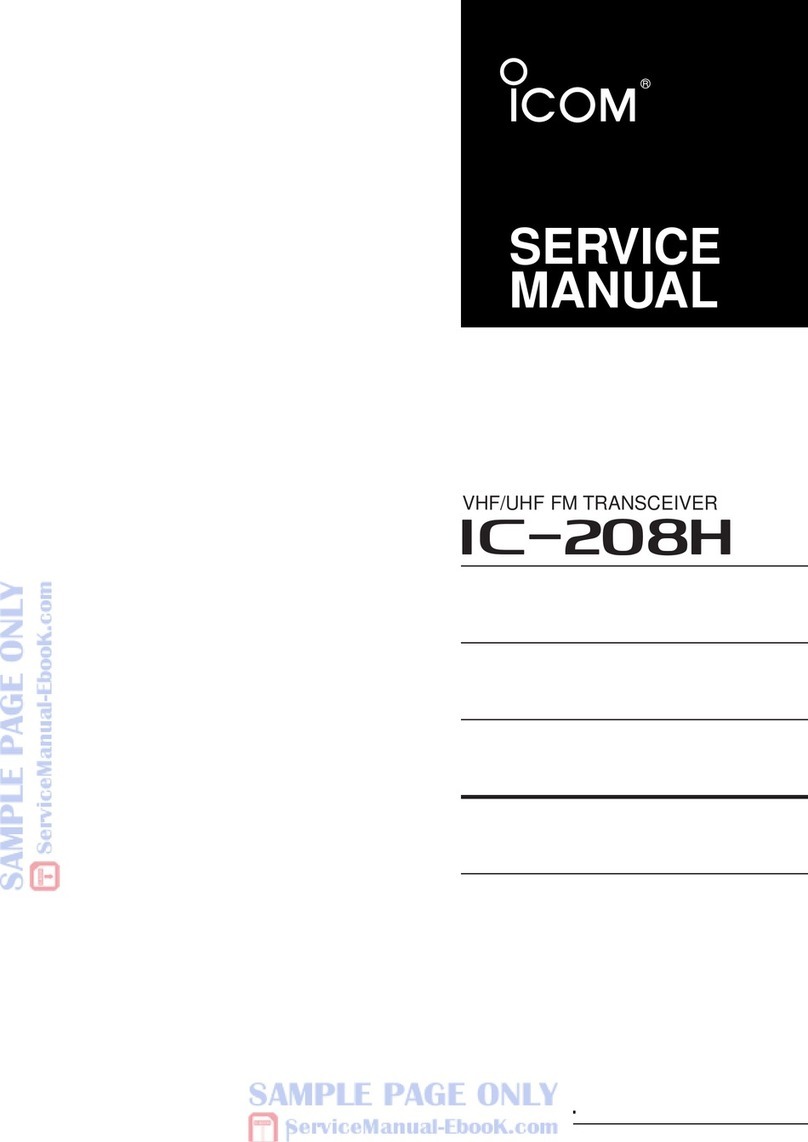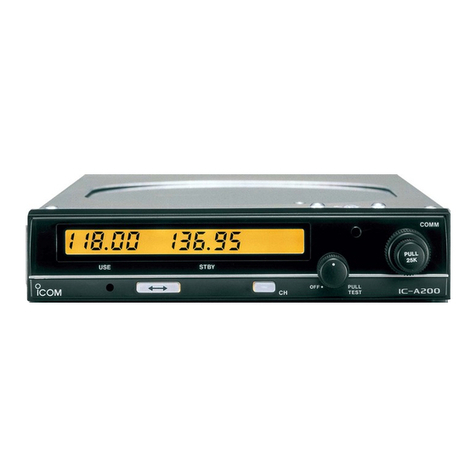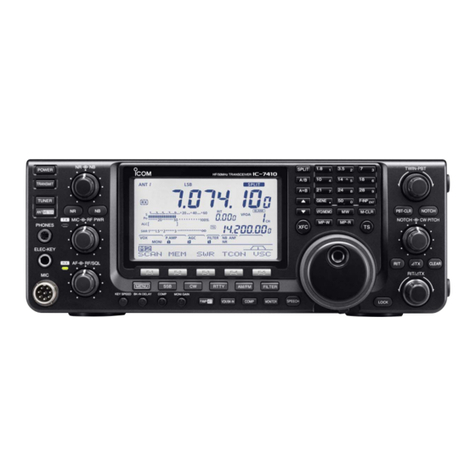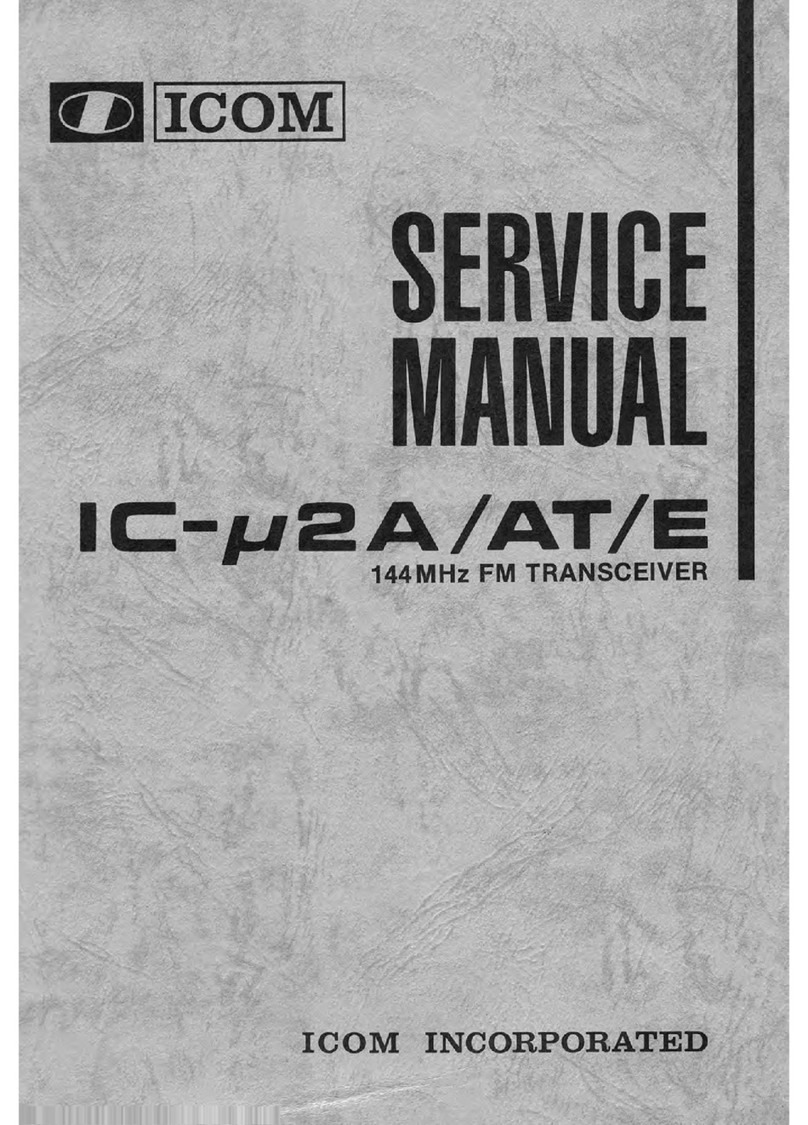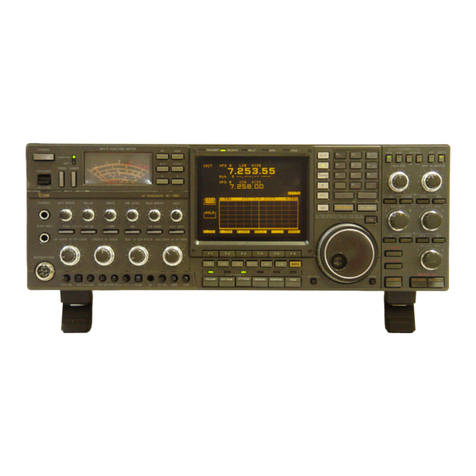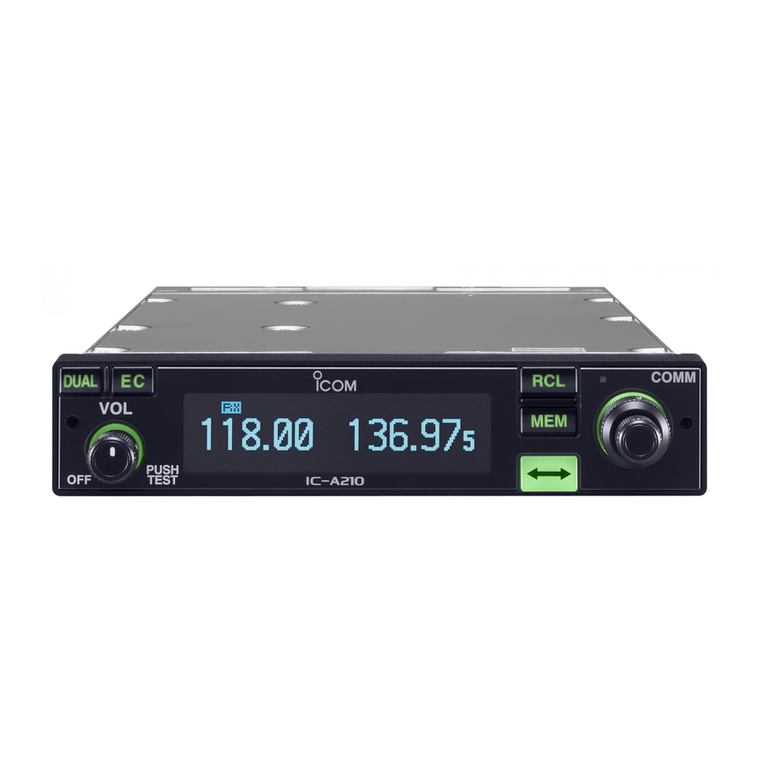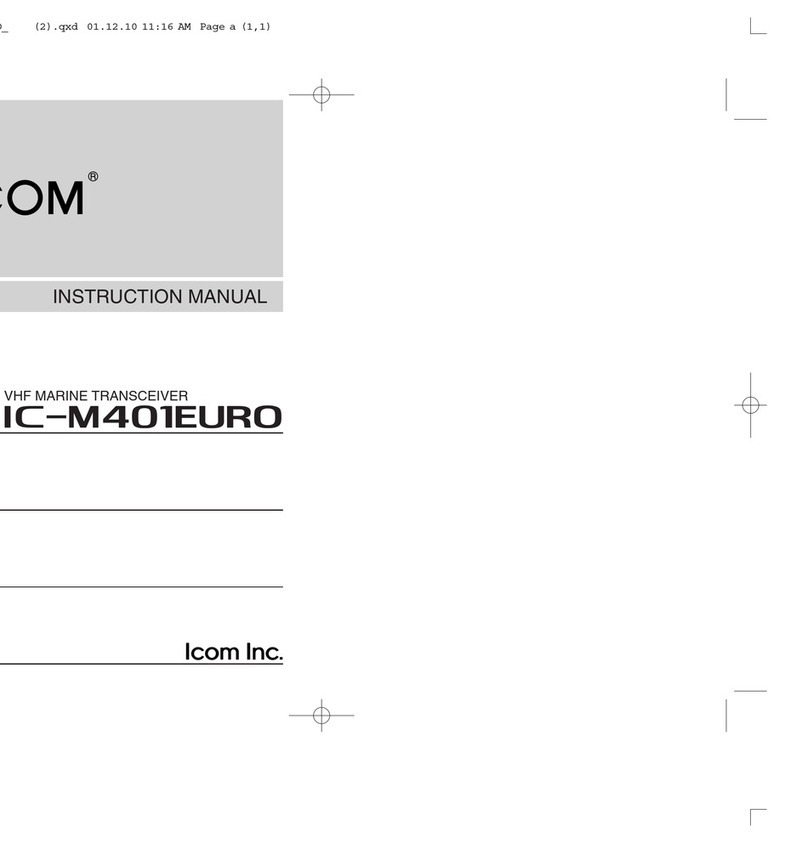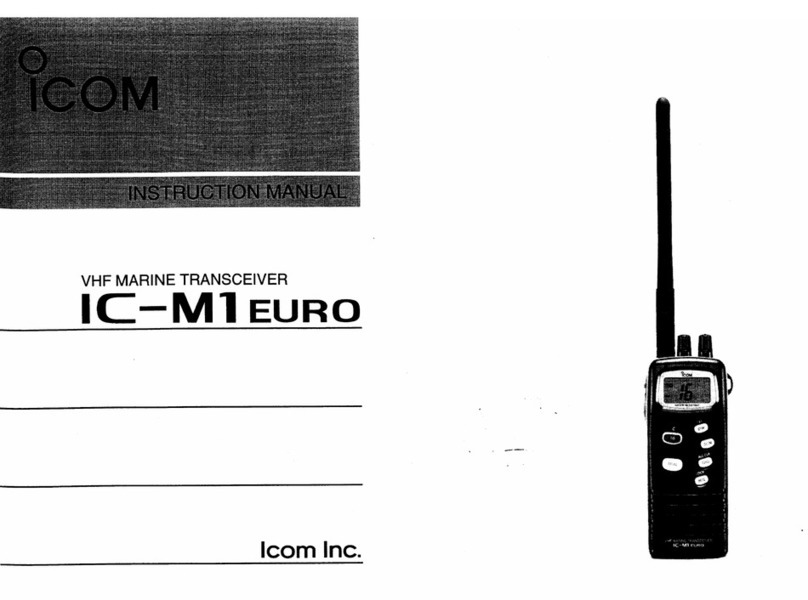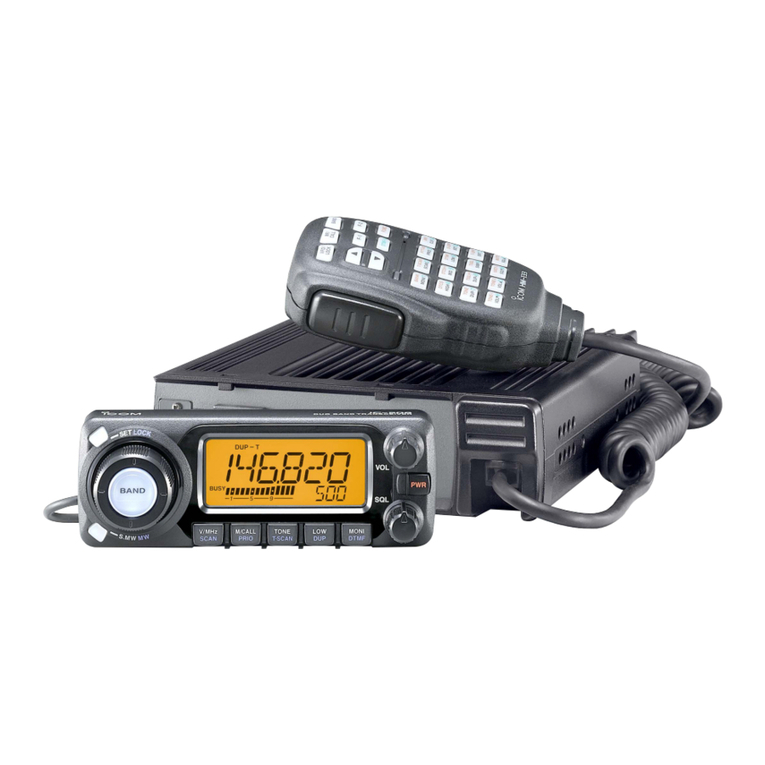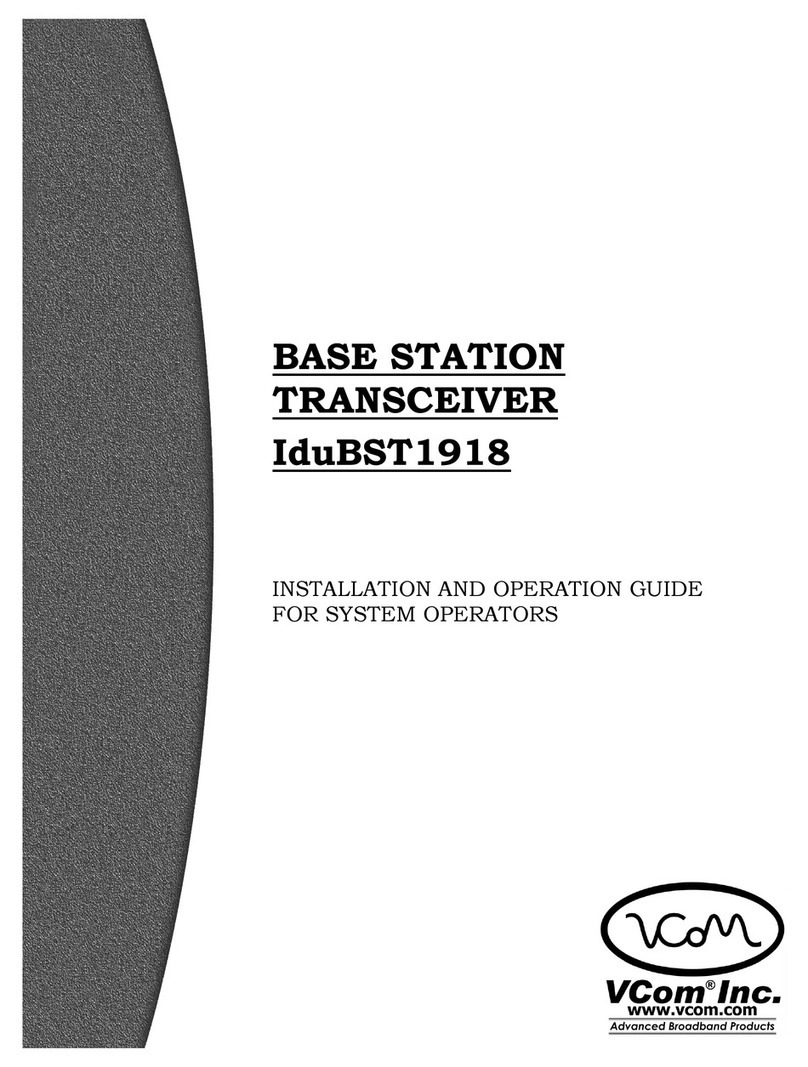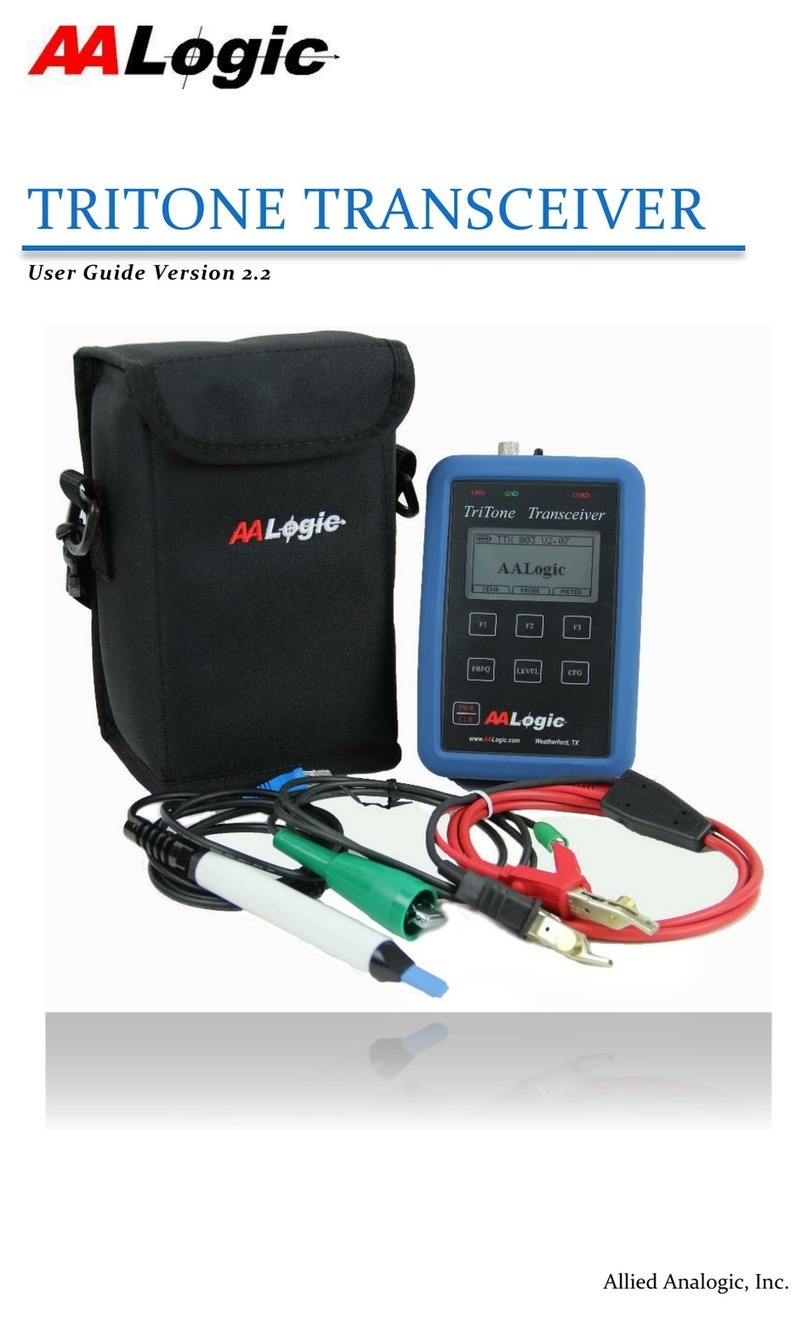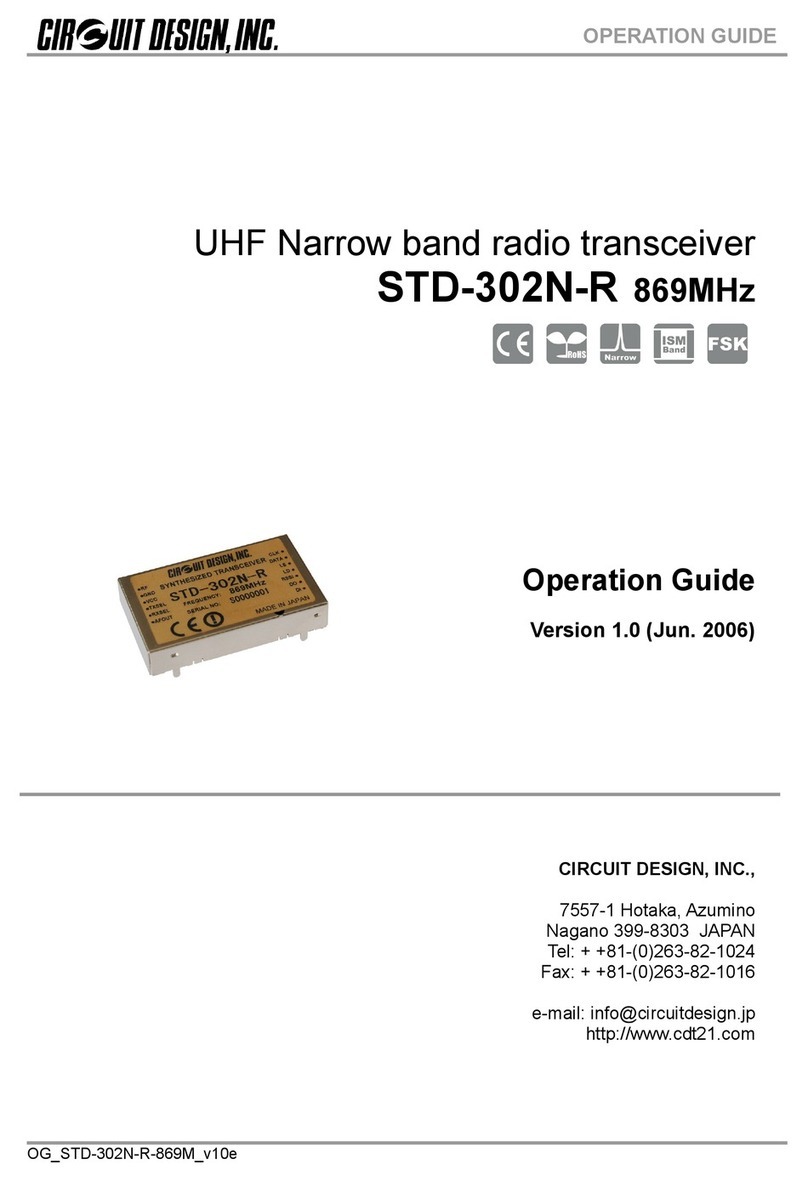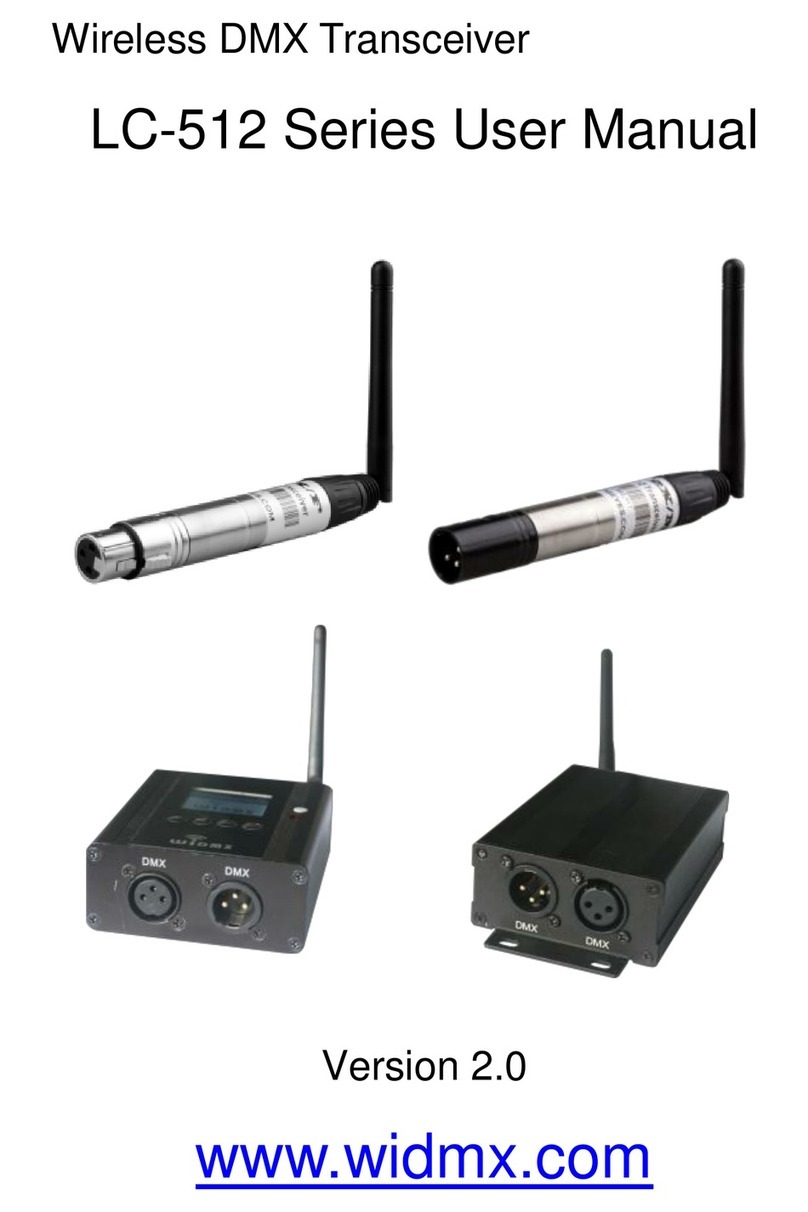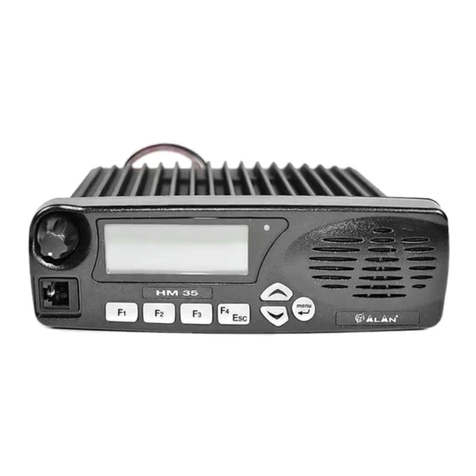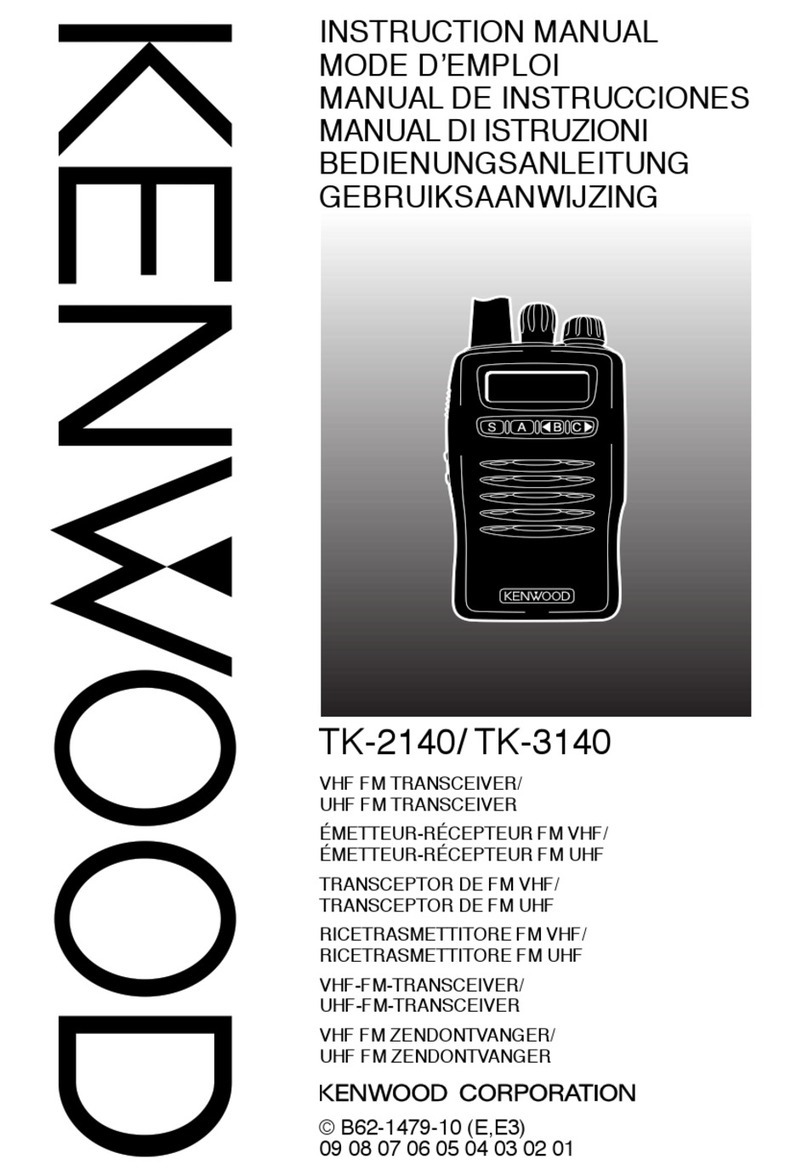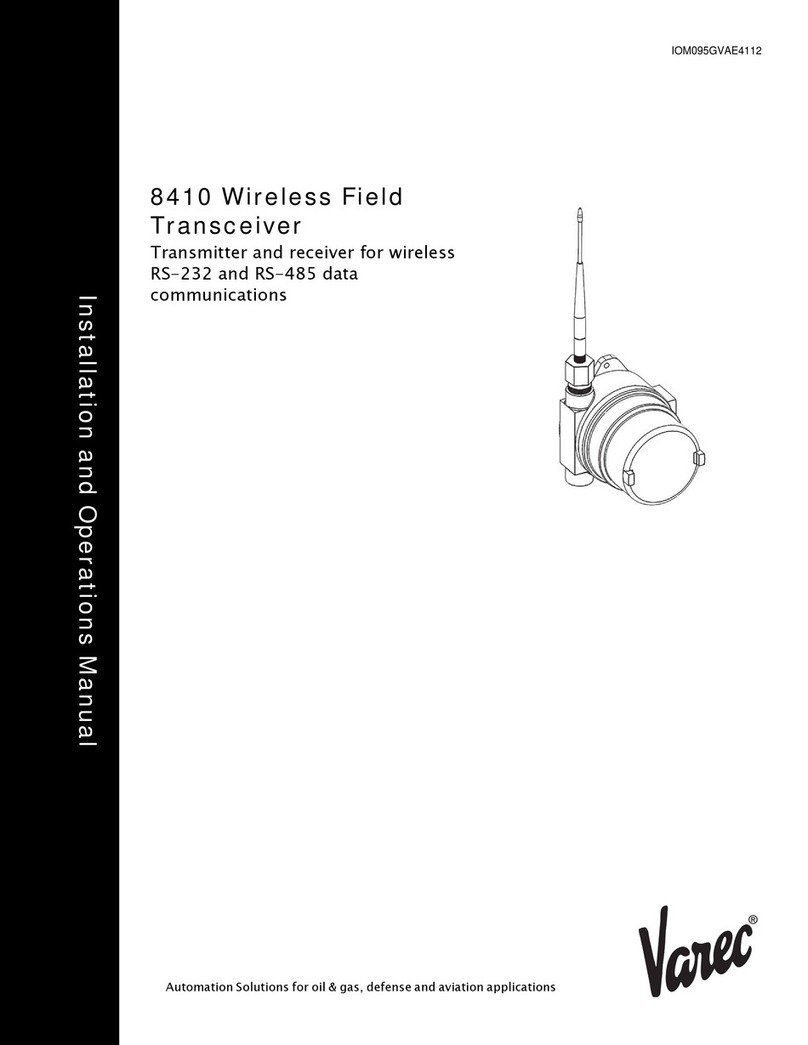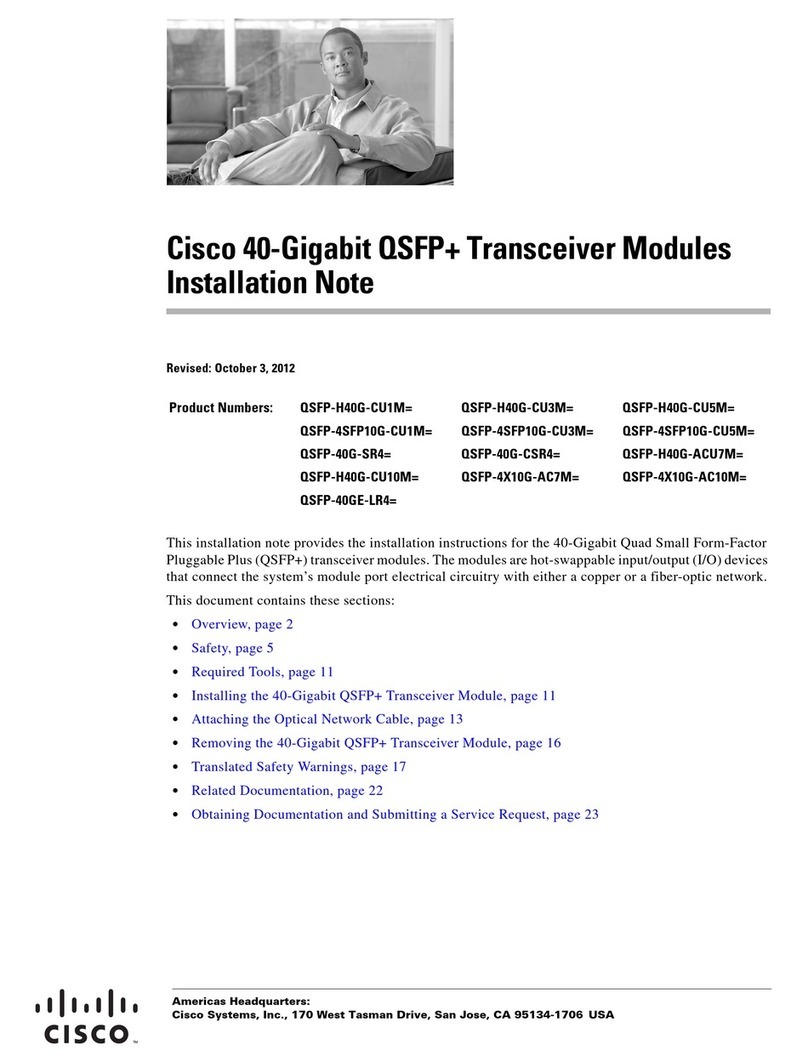Icom IC-F2000 series User manual

SERVICE
MANUAL
S-15609XZ-C1-1
March 2020
UHF TRANSCEIVERS
(For versions without ANT PCB)
|F2000
|F2000S
|F2000T

INTRODUCTION
We will begin supplying spare units for all versions of the
IC-F2000 series described in this service manual.
Accordingly, this revised service manual focuses on the
spare units that can be supplied, consumable parts and
parts that are considered necessary in case of physical
damage, instead of those on the individual electronic parts
list and mechanical parts list.
This service manual describes the latest technical
information for the following versions of the IC-F2000/
IC-F2000S/IC-F2000T UHF TRANSCEIVERS
at the time of publication.
MODEL
VERSION VERSION
NUMBER
FREQUENCY
RANGE
(MHz)
CHANNEL
SPACING
(kHz)
KEY
TYPE
IC-F2000
#11 EUR-09
400~470
12.5/20/25 Non#12 UK-09
#13 EXP-09 12.5/25
IC-F2000S
#14 EUR-09 12.5/20/25 4-key
#15 UK-09
#16 EXP-09 12.5/25
IC-F2000T
#17 EUR-09 12.5/20/25
10-key
#18 UK-09
#19 EXP-09
12.5/25
#21 EXP-10
IC-F2000
#23
EXP-11 450~520
Non
IC-F2000S
#24 4-key
IC-F2000T
#25
10-key
IC-F2000
#35
AUS-09 400~470
Non
IC-F2000S
#36 4-key
IC-F2000T
#37
10-key
IC-F2000
#38
AUS-10 450~520
Non
IC-F2000S
#39 4-key
IC-F2000T
#40
10-key
IC-F2000
#42
USA-07 400~470
12.5
Non
IC-F2000S
#43 4-key
IC-F2000T
#44
10-key
IC-F2000
#48
USA-08 450~512
Non
IC-F2000S
#49 4-key
IC-F2000T
#50
10-key
To upgrade quality, any electrical, mechanical parts and
internal circuits are subject to change without notice or
obligation.
For the following versions, see the IC-F2000/
IC-F2000S/IC-F2000T Service Manual (for with ANT
PCB).
MODEL
VERSION VERSION
NUMBER
FREQUENCY
RANGE
(MHz)
CHANNEL
SPACING
(kHz)
KEY
TYPE
IC-F2000
#01 USA-01
400~470
12.5
Non
#02 EUR-01 12.5/20/25
#03 UK-01 12.5/25
#04 EXP-01
IC-F2000S
#05 USA-01 12.5
4-key
#06 EUR-01 12.5/20/25
#07 UK-01 12.5/25
#08 EXP-01
IC-F2000T
#09 USA-01 12.5
10-key
#10 EUR-01 12.5/20/25
#11 UK-01 12.5/25
#12 EXP-01
IC-F2000
#21 USA-02 450~512 12.5 Non
#22 EXP-02 450~520 12.5/25
IC-F2000S
#23 USA-02 450 ~512 12.5
4-key
IC-F2000T
#25
10-key
#26 EXP-02 450~520 12.5/25
#82 EXP-03 400~470

Icom, Icom Inc. and the Icom logo are registered trademarks of Icom Incorporated (Japan) in Japan, the United States, the
United Kingdom, Germany, France, Spain, Russia, Australia, New Zealand, and/or other countries.
SERVICE CAUTION
NEVER connect the transceiver to an AC outlet or
to a DC power supply that outputs more than the
specified voltage. This will ruin the transceiver.
DO NOT reverse the polarity of the DC power cable
when directly connecting to the transceiver.
DO NOT apply an RF signal of more than 20 dBm
(100 mW) to the antenna connector. This could
damage the transceiver’s front-end.
ORDERING PARTS
Be sure to include the following four points when
ordering replacement parts:
1. 10-digit Icom part or order number
2. Component name
3. Equipment model name and unit name
4. Quantity required
<ORDER EXAMPLE>
8610014711 KNOB N-421-1 IC-F2000 CHASSIS 5 pieces
03 4112110 3
U F2000 #11 CHASSIS
IC-F2000 CHASSIS 1 piece
REPAIR NOTES
1. Make sure that the problem is internal before
disassembling the transceiver.
2. DO NOT open the transceiver until it is
disconnected from its power source.
3. DO NOT short any circuits or electronic parts.
DO NOT keep power ON for a long time when the
transceiver is defective.
4. NEVER directly transmit power into any test
equipment such as Standard Signal Generator,
otherwise the RF power may damage them.
5. ALWAYS connect a 30 dB to 40 dB attenuator
between the transceiver and such test equipment.
6. READ the instructions of the test equipment
thoroughly before connecting it to the transceiver.
7. If the front panel and chassis are separated and
reassembled, waterproof performance will not be
guaranteed unless the specified waterproof check
is performed.
IC-F2000 IC-F2000S IC-F2000T

TABLE OF CONTENTS
SECTION 1 SPECIFICATIONS
SECTION 2 INSIDE VIEWS
SECTION 3 DISASSEMBLY INSTRUCTIONS
SECTION 4 ADJUSTMENT PROCEDURE
4 -1 PREPA R ATI ON ……………………………………………………………………………………… 4-1
4-2 FREQUENCY ADJUSTMENTS …………………………………………………………………… 4-6
4-3 TRANSMIT ADJUSTMENTS ……………………………………………………………………… 4-8
4-4 RECEIVE ADJUSTMENTS …………………………………………………………………………4-14
4-5 AFTER THE ADJUSTMENT ………………………………………………………………………4-19
SECTION 5 SPARE UNITS AND PARTS
SECTION 6 BOARD LAYOUT
SECTION 7 BLOCK DIAGRAM
SECTION 8 VOLTAGE DIAGRAM

1-1
SECTION 1 SPECIFICATIONS
MODEL VERSION FREQUENCY
COVERAGE (MHz)
CORRESPONDING
MEASUREMENT STANDARD
IC-F2000
EUR-09
400~470
EN 300 086, EN 300 296
UK-09
EXP-09 RS S -119
IC-F2000S
EUR-09 EN 300 086, EN 300 296
UK-09
EXP-09 RS S -119
IC-F2000T
EUR-09 EN 300 086, EN 300 296
UK-09
EXP-09 RS S -119
EXP-10
IC-F2000
EXP-11 450~520 TIA-603 equivalentIC-F2000S
IC-F2000T
IC-F2000
AUS-09 400~470
AS/NZS 4295
IC-F2000S
IC-F2000T
IC-F2000
AUS-10 450~520IC-F2000S
IC-F2000T
IC-F2000
UAS-07 400~470 TIA-603, RSS-119IC-F2000S
IC-F2000T
IC-F2000
USA-08 450~512 TIA-603IC-F2000S
IC-F2000T
■GENERAL
• Frequency coverage: See the table shown above.
• Number of conventional channels: 16 channels (Non-display type)
128 channels (4-key and 10-key types)
• Type of emission: Wide 16K0F3E (25.0 kHz) (EN 300 086, EN 300 296, AZ/NZS 4295)
Middle 14K0F3E (20.0 kHz) (EN 300 086, EN 300 296)
Narrow 11K50F3E (12.5 kHz) (TIA-603, RSS-119)
8K50F3E (12.5 kHz) (EN 300 086, EN 300 296, AZ/NZS 4295)
• Antenna impedance: 50 Ω (nominal)
• Operating temperature range: −25ºC~+55ºC (EN 300 086, EN 300 296)
−30ºC~+60ºC (−22ºF~+140ºF) (TIA-603, RSS-119, AZ/NZS 4295)
• Power supply voltage: Specified Icom's battery packs only, 7.5 V DC (negative ground)
• Current drain (approximate):
Receiving 80 mA (stand-by)
500 mA (at maximum audio, with the internal speaker)
Transmitting 1300 mA (at 4 W)
• Dimensions (projections not included):
With BP-278 52.2 (W)×111.8 (H)×22.3 (D) mm, 2.1 (W)×4.4 (H)×0.9 (D) inches
With BP-279 52.2 (W)×111.8 (H)×24.5 (D) mm, 2.1 (W)×4.4 (H)×1.0 (D) inches
With BP-280 52.2 (W)×111.8 (H)×30.3 (D) mm, 2.1 (W)×4.4 (H)×1.2 (D) inches
• Weight (approximate):With BP-278 230 g, 8.1 oz
With BP-279 240 g, 8.5 oz
With BP-280 270 g, 9.5 oz

1-2
■TRANSMITTER
• Output power: 4 W
• Modulation: Variable reactance frequency modulation
• Maximum permissible deviation:
Wide ±5.0 kHz
Middle ±4.0 kHz
Narrow ±2.5 kHz
• Frequency stability: ±2.5 ppm
• Spurious emissions: 0.25 μW (≤1 GHz) (EN 300 086, EN 300 296, AZ/NZS 4295)
1.0 μW (>1 GHz) (EN 300 086, EN 300 296, AZ/NZS 4295)
70 dB minimum (TIA-603, RSS-119)
• Adjacent channel selectivity:
Wide, Middle 70 dB minimum, 74 dB typical
Narrow 60 dB minimum, 69 dB typical
• Audio harmonic distortion:
Wide, Middle 1.0% typical at AF 1 kHz 40% deviation
Narrow 1.5% typical at AF 1 kHz 40% deviation
• FM hum and Noise:
With CCITT Filter Wide 45 dB minimum, 53 dB typical (EN 300 086, EN 300 296)
Middle 43 dB minimum, 51 dB typical (EN 300 086, EN 300 296)
Narrow 40 dB minimum, 48 dB typical (EN 300 086, EN 300 296)
Without CCITT Filter Wide 40 dB minimum, 46 dB typical (AZ/NZS 4295)
Narrow 34 dB minimum, 40 dB typical (TIA-603, RSS-119, AZ/NZS 4295)
• Input impedance (Microphone):2.2 kΩ
■RECEIVER
• Intermediate frequencies: 1st 46.35 MHz
2nd 450 kHz
• Sensitivity: −4 dBμV emf typical at 20 dB SINAD (EN 300 086)
0.25 μV*typical at 12 dB SINAD (TIA-603, RSS-119, AS/NZS 4295)
• Squelch sensitivity (threshold):−8 dBμV emf typical (EN 300 086)
0.25 μV*typical (TIA-603, RSS-119, AS/NZS 4295)
• Adjacent channel selectivity:
Wide 70 dB minimum, 75 dB typical
Middle 70 dB minimum, 73 dB typical
Narrow 60 dB minimum, 67 dB typical
• Spurious response: 70 dB minimum
• Intermodulation: 65 dB minimum (EN 300 086)
70 dB minimum, 73 dB typical (TIA-603, RSS-119, AS/NZS 4295)
• Hum and Noise:
With CCITT Filte Wide 45 dB minimum, 52 dB typical (EN 300 086)
Middle 43 dB minimum, 50 dB typical (EN 300 086)
Narrow 40 dB minimum, 47 dB typical (EN 300 086)
Without CCITT Filter Wide 40 dB minimum, 46 dB typical (AS/NZS 4295)
Narrow 34 dB minimum, 40 dB typical (TIA-603, RSS-119, AS/NZS 4295)
• Audio output power: Internal speaker 1.5 W typical (at 5% distortion into the 8 Ω load)
External speaker 0.4 W typical (at 5% distortion into an 8 Ω load)
• Output impedance (Speaker):8 Ω
*
The input signal strength level of this receive sensitivity is measured at the load end (PD).
All stated specifications are subject to change without notice or obligation.

2-1
SECTION 2 INSIDE VIEWS
• MAIN/MAIN-A UNIT (TOP VIEW)
[Emer] (S5)
[P2] (S17)
[P3] (S21)
[2] (S7)
[3] (S8)
[6] (S12)
[8] (S15)
[9] (S16)
[MIC] (J1)
[SP] (J2)
AF AMPLIFIER
(IC1)
BASEBAND IC
(IC4)
LCD
(DS2)
LCD DRIVER (IC21)
Under the LCD
14.7456 MHz
BASEBAND IC CLOCK
(X1)
POWER CONTROLLER
(Q9)
[ ] (S20)
ANTENNA CONNECTOR
(J1: CHASSIS UNIT)
CHASSIS
APC AMPLIFIER
(IC17)
VOX AMPLIFIER
(IC3)
MICROPHONE GAIN
CONTROLLER
(IC2)
MICROPHONE
(MC1)
[PTT] (S1)
[UP]/[Upper] (S2)
MAIN/MAIN-B UNIT
[DOWN]/[Lower] (S3)
[P1] (S13)
[P0] (S9)
[1] (S6)
[5] (S11)
[4] (S10)
[7] (S14)
[0] (S19)
[ ] (S18)
+5 V REGULATOR
(IC19)

2-2
• MAIN/MAIN-B UNIT (BOTTOM VIEW)
BUFFER AMPLIFIER
(IC7)
LOCK VOLTAGE SWITCH
(IC14)
[ROTARY SELECTOR] (S4)
[VOL] (R27)
MICROPHONE AMPLIFIER
(IC12)
POWER AMPLIFIER
(Q38)
DRIVE AMPLIFIER
(Q36)
PREAMPLIFIER
(Q35)
LOW-PASS FILTER/
SUMMING AMPLIFIER
(IC11)
VCO CIRCUIT
Under the VCO cover
PLL IC
(IC15)
MOTION SENSOR
(IC22)
EEPROM
(IC13)
LEVEL CONVERTER
(IC23)
+3 V REGULATOR
(IC24)
+5 V REGULATOR
(IC20)
MIXER
(Q37)
RF AMPLIFIER
(Q39)
46.35 MHz
BANDPASS FILTER
(FI1)
D/A CONVERTER
(IC10)
IF IC
(IC16)
LOW-PASS FILTER
(IC5)
CPU
(IC9)
CPU5 REGULATOR
(IC6)
RESET IC
(IC8)
15.3 MHz
REFERENCE OSCILLATOR
(X3)
12.228 MHz CPU CLOCK
(X2)

3-1
SECTION 3 DISASSEMBLY INSTRUCTIONS
1. REMOVING THE FRONT PANEL
1) Remove the dial knob, volume knob and antenna nut
from the top of the front panel.
Volume knob
Dial knob
Antenna nut
Remove with;
“ICOM Driver (K)”
(8960000113)
Front panel
2) Remove the 2 screws from the bottom of chassis.
Remove the 2 screws from the jack cover, and then
remove the jack cover from the front panel.
Chassis
Jack cover
Front panel
Screws ×2
Screws ×2
3) Screw just the end the M3 screw into the screw hole in
the chassis, and then remove the chassis from the front
panel.
Chassis
Front panel
M3 screw (screw thread pitch: 0.5 mm)
The M3 screws are commercially available.
When ordering parts, the following parts
are recommended.
“PH M3×16 SUS” (8810000620)

3-2
2. REMOVING THE MAIN/MAIN-B UNIT
1) Remove the 2 volume nuts from the top of the chassis,
and then remove the top plate.
Chassis
Top plate
Volume nuts
Remove with;
“ICOM Driver (AG)”
(8960000561)
2) Remove the 9 screws from the MAIN/MAIN-B UNIT.
MAIN/MAIN-B UNIT
Screws ×9
3)
Remove the 2 screws from the heatsink of MAIN/MAIN-B
UNIT.
MAIN/MAIN-B UNIT
Heatsink
Screws ×2
4) Remove the side plate from the chassis.
Chassis
Side plate
5) Remove the MAIN/MAIN-B UNIT from the chassis.
MAIN/MAIN-B UNIT
Chassis

4-1
SECTION 4 ADJUSTMENT PROCEDURE
4-1 PREPARATION
■REQUIRED EQUIPMENT
EQUIPMENT GRADE AND RANGE EQUIPMENT GRADE AND RANGE
Programming
software
CS-F2000 PROGRAMMING
SOFTWARE (Revision 1.31 or later) Programming cable OPC-478UC
DC power supply Output voltage: 7.5 V
Current capacity: More than 2 A
Standard signal
generator (SSG)
Frequency range: 0.1~600 MHz
Output level: −20 to 90 dBμ
(−127 to −17 dBm)
RF power meter
(50 Ω terminated)
Measuring range: 0.1~10 W
Frequency range: 100~600 MHz
SWR: Less than 1.2 : 1
AC millivoltmeter Measuring range: 10 mV to 10 V
Frequency counter Range: 0.1~600 MHz
Accuracy: ±1 ppm or better
Modulation analyzer Frequency range: 30~600 MHz
Measuring range: 0 to ±10 kHz Distortion meter Measuring accuracy: 3% or less at 1 kHz
Input level: 50 mV to 10 V
Attenuator Attenuation: 30 dB or 40 dB
Capacity: More than 10 W External speaker Input impedance: 8 Ω
Rated input power: More than 1 W
Audio generator
(AG)
Frequency range: 300~3000 Hz
Output level: 1~500 mV
Ammeter Measuring range: 0 to 2 A
Spectrum analyzer Measuring range: Up to 3 GHz
■SAVE THE PROGRAMMING DATA
• Adjusting the transceiver will change the programming setting.
• Before adjusting, save the programming data of the transceiver with the programming software.
★
After adjusting, write back the programming data.
■CONNECTIONS
IC-F2000/IC-F2000S/IC-F2000T
IC-F2000/IC-F2000S/IC-F2000T
Rear panel view
Modulation analyzer
30~600 MHz/0 to ±10 kHz
Spectrum analyzer
Up to 3 GHz
to the antenna connector
Frequency
counter
Standard signal generator
–20 to 90 dBµ
(–127 to –17 dBm)
Loose couple
Attenuator
30 dB or 40 dB
RF power meter
0.1~10 W/50 Ω
Ammeter
0 to 2 A
DC power supply
7.5 V/2 A
PC
to USB port
OPC-478UC
JIG cable 2:
JIG cable 1:
See the illustration
shown on page 4-2.
To [MIC]
To [SP]
See the illustration
shown on page 4-2.
CAUTION!
NEVER transmit while
the SSG is connected to
the antenna connector.

4-2
■JIG
• JIG cable 1
3-conductor 2.5 (d) mm plug
(MIC)
(GND)
+−
AC MILLIVOLTMETER
(10 mV to 10 V)
+−
AUDIO GENERATOR
(300~3000 Hz/1~500 mV)
(MIC)
(GND)
33 kΩ
4.7 µF
+
PTT
• JIG cable 2
3-conductor 3.5 (d) mm plug
(GND)
(CLONE)
OPC-478UC
3-conductor 3.5 (d) mm jack
+−
EXTERNAL SPEAKER
(1 W/8 Ω)
+
−
DISTORTION METER
(3% or less at 1 kHz/50 mV ~ 10 V)
(CLONE)
(GND)
(SP)
(SP)

4-3
■ADJUSTMENT CHANNELS
• For 400~470 MHz versions

4-4
■ADJUSTMENT CHANNELS (CONTINUED)
• For 450~512/520 MHz versions
CONVENIENT: The programming les for the
adjustment channels described on page 4-3 and 4-4
are available.
Right-click the clip icon ( ) below, and select "Save
Embedded File to Disk."
• For 400~470 MHz versions
• For 450~512/520 MHz versions
For [EUR] and [UK]:
When adjusting and verifying the middle band, change
the Middle bandwidth to “Middle,” as shown below.

4-5
■ADJUST UTILITY
Click to open the
“I/O Check window”
ADJUST CHANNEL
S-METER
TX OUTPUT POWER
TX OUTPUT POWER
MODULATION BALANCE
FM DEVIATION
CTCSS/DTCS DEVIATION
PLL LOCK VOLTAGE
RX SENSITIVITY
MODULATION BALANCE
FM DEVIATION
CTCSS/DTCS DEVIATION
AUTO ADJUST CHANNEL
SQUELCH
REFERENCE FREQUENCY
Memory channel designation
(for manual adjustment and verification)
Memory channel designation
(for automatic adjustment)
If the window below appears, the utility is password-protected.
Ask the person who set the password.
Enter the password to open the "Adjust Utility" window.

4-6
4-2 FREQUENCY ADJUSTMENTS
1) Select an adjustment item using [↑]/[↓]/[←]/[→] on the PC’s keyboard.
2) Set or modify the adjustment value as specified using [Space]/[Back Space] on the PC’s keyboard.
ADJUSTMENT TRANSCEIVER’S
CONDITION OPERATION ADJUSTMENT
ITEM VALUE
PLL LOCK
VOLTAGE
- Preparation -
1 – • Set the preset memory channel
numbers on the adjust utility
window.
[CH No. FL] 1
[CH No. FC] 2
[CH No. FH] 3
2 • Verify or set the preset value on
the adjust utility window.
[LV (RX LVA FL)] 1.0 V
[LV (TX LVA FL)]
[LV (RX LVA FH)] For 400~470 MHz
versions: 2.75 V
For 450~512/520 MHz
versions: 255
( The value is the fixed
setting value for the item.)
[LV (TX LVA FH)] 3.8 V
- Adjustment -
(RX Band low)
3 – • Connect the RF power meter to the
antenna connector.
[RX LVA Start] Push [ENTER]
(Enters the
Adjustment mode)
4 • Receiving [RX LVA FL] Push [ENTER]
(Automatic adjustment)
5–[RX LVA Start] Push [ENTER]
(Saves the value)
(RX Band high) 6 • Receiving [RX LVA FH] Push [ENTER]
(Automatic adjustment)
7–[RX LVA Start] Push [ENTER]
(Saves the value)
(TX Band low) 8–[TX LVA Start] Push [ENTER]
(Enters the
Adjustment mode)
9 • Transmitting [TX LVA FL] Push [ENTER]
(Automatic adjustment)
10 –[TX LVA Start] Push [ENTER]
(Saves the value)
(TX Band high) 11 • Transmitting [TX LVA FH] Push [ENTER]
(Automatic adjustment)
12 –[TX LVA Start] Push [ENTER]
(Saves the value)
Continued on the next page…

4-7
ADJUSTMENT TRANSCEIVER’S
CONDITION OPERATION ADJUSTMENT
ITEM VALUE
PLL LOCK
VOLTAGE
- Verification -
(RX Band low)
13 • CH No.: 1
• Receiving
• Click button to display the "I/O
Check" window as shown below.
• Click [Update (F5)] to re-load the
latest value for each item.
[LVIN]
(On the "I/O
Check" window)
For 400~470 MHz
versions: 0. 9 ~1.1 V
For 450~512/520 MHz
versions: 0.8~1.2 V
(RX Band high) 14 • CH No.: 3
• Receiving
For 400~470 MHz
versions: 2.55~2.95 V
For 450~512/520 MHz
versions:
Less than 4.0 V
(TX Band low) 15 • CH No.: 1
• Transmitting
For 400~470 MHz
versions: 0. 9 ~1.1 V
For 450~512/520 MHz
versions: 0.8~1.2 V
(TX Band high) 16 • CH No.: 3
• Transmitting
3.6~4.0 V
REFERENCE
FREQUENCY
- Adjustment -
(Band high)
1 • CH No.: 3
• Transmitting
• Loosely couple the frequency
counter to the antenna connector.
[REF Data] For 400~470 MHz
versions:
470.000000 MHz
(±500 Hz)
For 450~512/520 MHz
versions:
520.000000 MHz
(±500 Hz)
- Verification -
(Band low)
2 • CH No.: 1
• Transmitting
–For 400~470 MHz
versions:
400.000000 MHz
(±500 Hz)
For 450~512/520 MHz
versions:
450.000000 MHz
(±500 Hz)
(Band center) 3 • CH No.: 2
• Transmitting
For 400~470 MHz
versions:
435.000000 MHz
(±500 Hz)
For 450~512/520 MHz
versions:
485.000000 MHz
(±500 Hz)
• I/O Check window
* * *
(The values shown above are only examples.
Each transceiver has own values.)
Lock voltage
4-2 FREQUENCY ADJUSTMENTS (CONTINUED)
1) Select an adjustment item using [↑]/[↓]/[←]/[→] on the PC’s keyboard.
2) Set or modify the adjustment value as specified using [Space]/[Back Space] on the PC’s keyboard.

4-8
4-3 TRANSMIT ADJUSTMENTS
1) Select an adjustment item using [↑]/[↓]/[←]/[→] on the PC’s keyboard.
2) Set or modify the adjustment value as specified using [Space]/[Back Space] on the PC’s keyboard.
ADJUSTMENT TRANSCEIVER’S
CONDITION OPERATION ADJUSTMENT
ITEM VALUE
TX OUTPUT
POWER
- Preparation -
1 – • Set the preset memory channel
numbers on the adjust utility
window.
[CH No. FL] 1
[CH No. FC] 2
[CH No. FH] 3
- Adjustment -
(High power,
Band low)
2 – • Connect the RF power meter to the
antenna connector.
[Power Start] Push [ENTER]
(Enters the
Adjustment mode)
3 • Transmitting [Power FL] 4.0 W
4 – [Power Start] Push [ENTER]
(Saves the value)
(High power,
Band center)
5 • Transmitting [Power FC] 4.0 W
6 – [Power Start] Push [ENTER]
(Saves the value)
(High power,
Band high)
7 • Transmitting [Power (FH)] 4.0 W
8 – [Power Start] Push [ENTER]
(Saves the value)
(L2 power,
Band low)
9 • CH No.: 4
• Transmitting
[Power (L2)] 2.0 W
(L1 power,
Band low)
10 • CH No.: 7
• Transmitting
[Power (L1)] 1.0 W
- Verification -
(High power,
Band low)
11 • CH No.: 1
• Transmitting
––3.0~5.0 W
(High power,
Band center)
12 • CH No.: 2
• Transmitting
(High power,
Band high)
13 • CH No.: 3
• Transmitting
(L2 power,
Band low)
14 • CH No.: 4
• Transmitting
1.0~3.0 W
(L2 power,
Band center)
15 • CH No.: 5
• Transmitting
(L2 power,
Band high)
16 • CH No.: 6
• Transmitting
(L1 power,
Band low)
17 • CH No.: 7
• Transmitting
0.5~2.0 W
(L1 power,
Band center)
18 • CH No.: 8
• Transmitting
(L1 power,
Band high)
19 • CH No.: 9
• Transmitting
FLOWING
CURRENT
- Verification -
(High power,
Band low)
1 • CH No.: 1
• Transmitting
• Connect the ammeter between
the transceiver and the DC power
supply.
– Less than 1.7 A
(High power,
Band center)
2 • CH No.: 2
• Transmitting
(High power,
Band high)
3 • CH No.: 3
• Transmitting
SPURIOUS
EMISSIONS
- Verification -
(High power,
Band low)
1 • CH No.: 1
• Transmitting
• Connect the spectrum analyzer to
the antenna connector through the
attenuator.
– Less than 70 dBc*1
Less than 0.25 μW*2
(≤1 GHz)
Less than 1.0 μW*2
(>1 GHz)
(High power,
Band center)
2 • CH No.: 2
• Transmitting
(High power,
Band high)
3 • CH No.: 3
• Transmitting
Continued on the next page…
*1For only [USA].
*2For other than [USA].

4-9
4-3 TRANSMIT ADJUSTMENTS (CONTINUED)
1) Select an adjustment item using [↑]/[↓]/[←]/[→] on the PC’s keyboard.
2) Set or modify the adjustment value as specified using [Space]/[Back Space] on the PC’s keyboard.
ADJUSTMENT TRANSCEIVER’S
CONDITION OPERATION ADJUSTMENT
ITEM VALUE
FM DEVIATION
- Preparation -
1 • Set [Mic Gain] to “2” in the Set mode. [Mic Gain] 2
2 – • Set the preset memory channel
numbers on the adjust utility
window.
[CH No. FL] 1
[CH No. FC] 2
[CH No. FH] 3
- Adjustment -
Narrow
(Band low)
3 – • Connect the modulation analyzer
to the antenna connector through
the attenuator, and set it to:
HPF: OFF
LPF: 20 kHz
De-emphasis: OFF
Detector: (P−P)/2
• Connect the audio generator and
AC millivoltmeter to [MIC] through
the JIG cable 1, and set it to:
Frequency: 1 kHz
Waveform: Sine wave
Level: 150 mV rms
[MOD Start] Push [ENTER]
(Enters the
Adjustment mode)
4 • Transmitting [MOD FL] ±2.10 kHz
(±0.05 kHz)
5 – [MOD Start] Push [ENTER]
(Saves the value)
(Band center) 6 • Transmitting [MOD FC] ± 2.10 kHz
(±0.05 kHz)
7 – [MOD Start] Push [ENTER]
(Saves the value)
(Band high) 8 • Transmitting [MOD FH] ±2.05 kHz
(±0.05 kHz)
9 – [MOD Start] Push [ENTER]
(Saves the value)
Wide*3
(Band low)
10 • CH No.: 10
• Transmitting
[MOD (Wide)] ±4.10 k Hz
(±0.05 kHz)
Middle*4
(Band low)
11 • CH No.: 13
• Transmitting
[MOD (Mid)] ±3.30 kHz
(±0.05 kHz)
MODULATION
BALANCE
- Preparation -
1 – • Set the preset values and memory
channel numbers on the adjust
utility window.
[TONE FL] 90
[TONE FC]
[TONE FH]
[TONE (Narrow)] 255
[CH No. FL] 16
[CH No. FC] 17
[CH No. FH] 18
- Adjustment -
Narrow
(Band low)
2 – • Connect the modulation analyzer
to the antenna connector through
the attenuator, and set it to:
HPF: OFF
LPF: 20 kHz
De-emphasis: OFF
Detector: (P−P)/2
• No audio signal is applied to [MIC].
[BAL Start] Push [ENTER]
(Enters the
Adjustment mode)
3 • Transmitting [BAL FL] ±1.00 kHz
(±0.05 kHz)
4 – [BAL Start] Push [ENTER]
(Saves the value)
(Band center) 5 • Transmitting [BAL FC] ±1.00 kHz
(±0.05 kHz)
6 – [BAL Start] Push [ENTER]
(Saves the value)
(Band high) 7 • Transmitting [BAL FH] ±1.00 kHz
(±0.05 kHz)
8 – [BAL Start] Push [ENTER]
(Saves the value)
Continued on the next page…
*3No adjustment or verification is necessary for [USA].
*4No adjustment or verification is necessary for [USA] and [AUS].

4-10
4-3 TRANSMIT ADJUSTMENTS (CONTINUED)
1) Select an adjustment item using [↑]/[↓]/[←]/[→] on the PC’s keyboard.
2) Set or modify the adjustment value as specified using [Space]/[Back Space] on the PC’s keyboard.
ADJUSTMENT TRANSCEIVER’S
CONDITION OPERATION ADJUSTMENT
ITEM VALUE
FM DEVIATION
- Verification -
Narrow
(Band low)
1 • CH No.: 1
• Transmitting
• Connect the audio generator and
AC millivoltmeter to [MIC] through
the JIG cable 1, and set it to:
Frequency: 1 kHz
Waveform: Sine wave
Level: 150 mV rms
–±1.8~±2.45 kHz
(Band center) 2 • CH No.: 2
• Transmitting
(Band high) 3 • CH No.: 3
• Transmitting
Wide*3
(Band low)
4 • CH No.: 10
• Transmitting
±3.6~±4.9 kHz
(Band center) 5 • CH No.: 11
• Transmitting
(Band high) 6 • CH No.: 12
• Transmitting
Middle*4
(Band low)
7 • CH No.: 13
• Transmitting
±2.8~±3.92 kHz
(Band center) 8 • CH No.: 14
• Transmitting
(Band high) 9 • CH No.: 15
• Transmitting
MODULATION
SENSITIVITY
- Verification -
Narrow
(Band low)
1 • CH No.: 1
• Transmitting
• Connect the modulation analyzer
to the antenna connector through
the attenuator, and set it to:
HPF: OFF
LPF: 20 kHz
De-emphasis: OFF
Detector: (P−P)/2
• Connect the audio generator and
AC millivoltmeter to [MIC] through
the JIG cable 1, and set it to:
Frequency: 1 kHz
Waveform: Sine wave
Level: 15.0 mV rms
–±1.10~±1.90 kHz
(Band center) 2 • CH No.: 2
• Transmitting
(Band high) 3 • CH No.: 3
• Transmitting
Wide*3
(Band low)
4 • CH No.: 10
• Transmitting
±2.20~±3.80 kHz
(Band center) 5 • CH No.: 11
• Transmitting
(Band high) 6 • CH No.: 12
• Transmitting
Middle*4
(Band low)
7 • CH No.: 13
• Transmitting
±1.75~±3.05 kHz
(Band center) 8 • CH No.: 14
• Transmitting
(Band high) 9 • CH No.: 15
• Transmitting
Continued on the next page…
*3No verification is necessary for [USA].
*4No verification is necessary for [USA] and [AUS].
Other manuals for IC-F2000 series
1
This manual suits for next models
2
Table of contents
Other Icom Transceiver manuals

Icom
Icom IC-M505 User manual

Icom
Icom IC-280 User manual
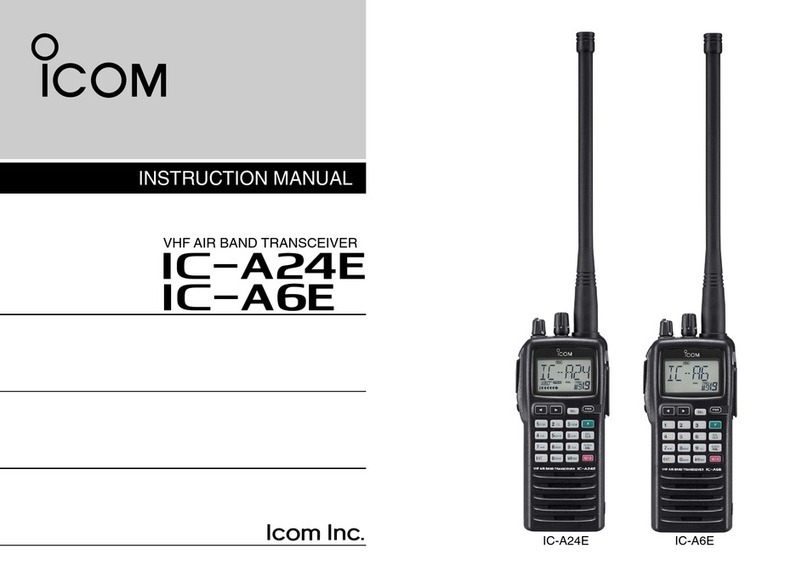
Icom
Icom IC-A24E User manual
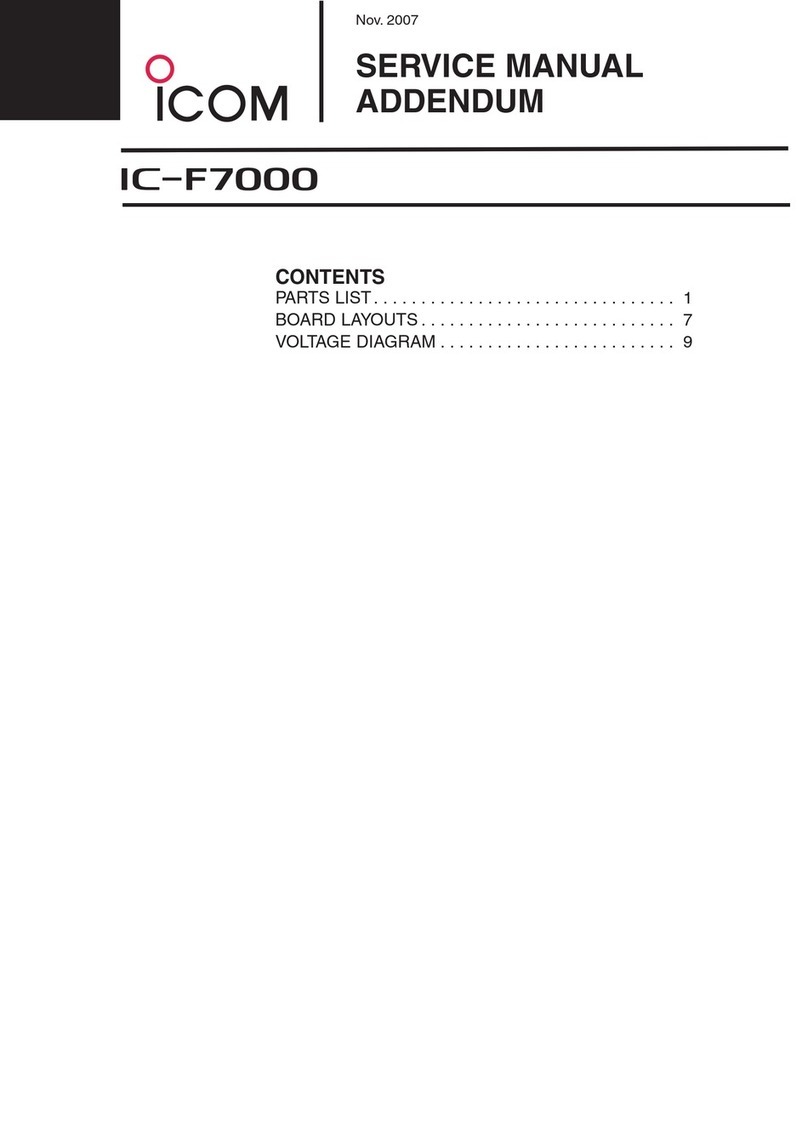
Icom
Icom IC-F7000 Installation and operating instructions
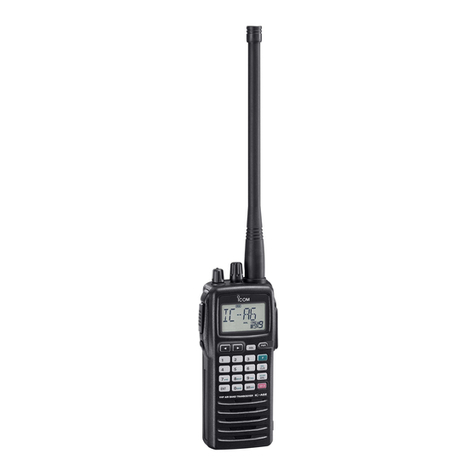
Icom
Icom IC-A24 User manual
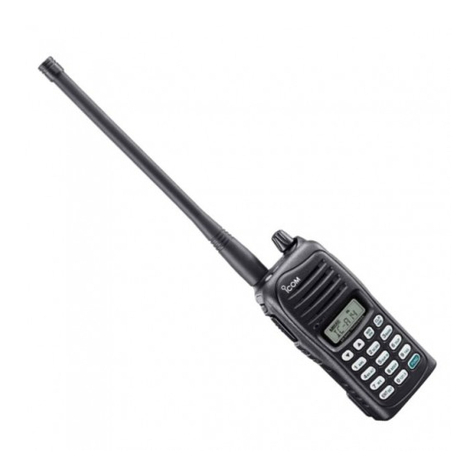
Icom
Icom IC-A14 User manual
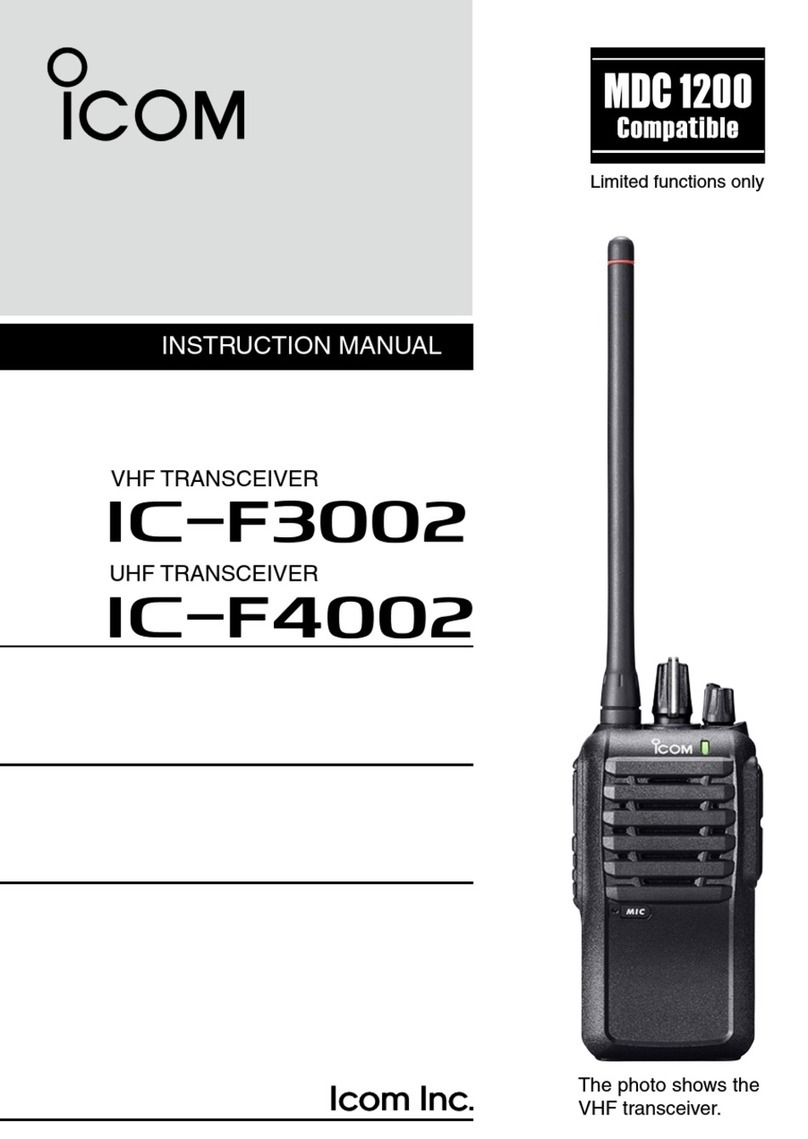
Icom
Icom iF3002 User manual
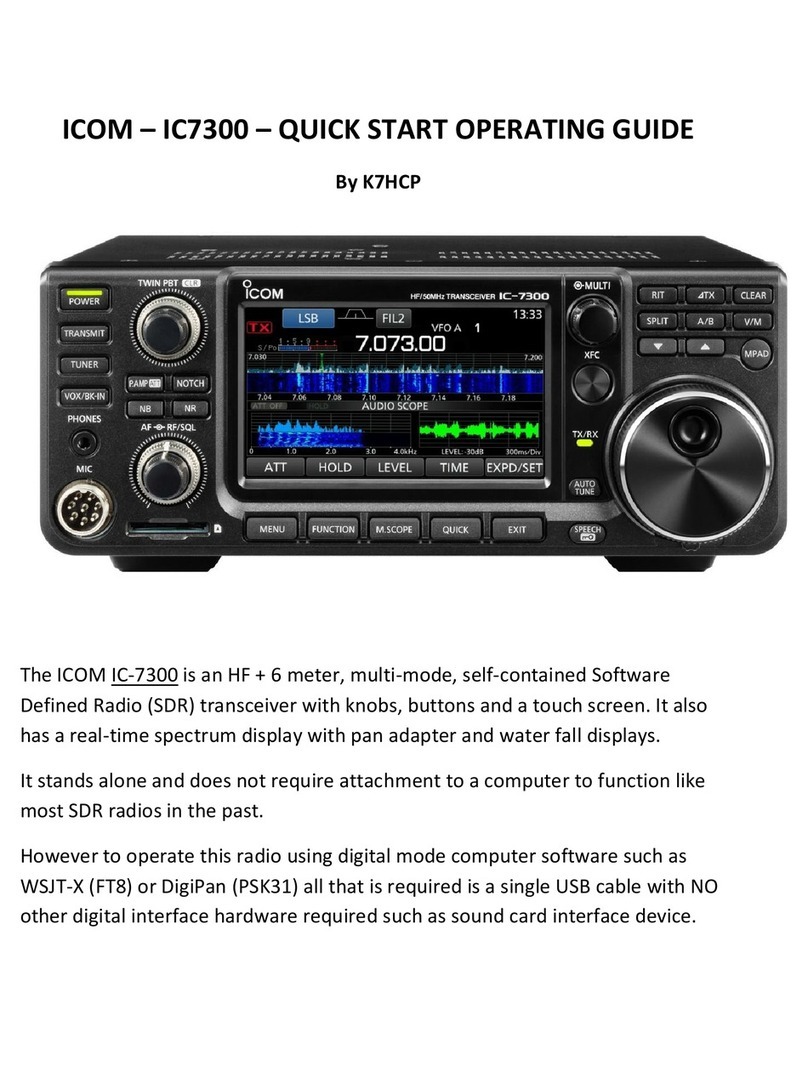
Icom
Icom IC-7300 User manual
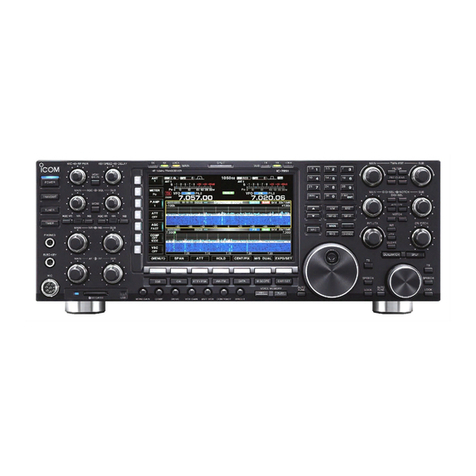
Icom
Icom IC-7851 Building instructions
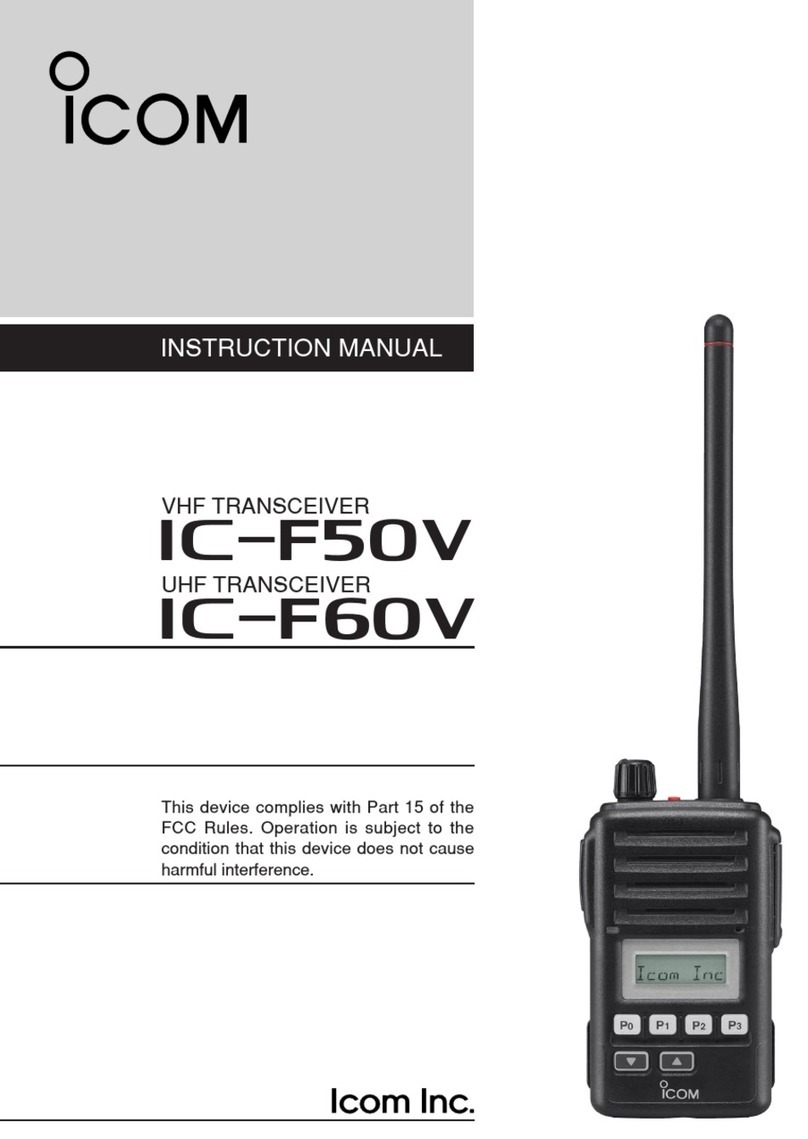
Icom
Icom IF50V User manual
Popular Transceiver manuals by other brands

Kenwood
Kenwood TM-3530A instruction manual

Kenwood
Kenwood TK-6110 instruction manual

ZyXEL Communications
ZyXEL Communications GBIC-LHX1310-40 user guide
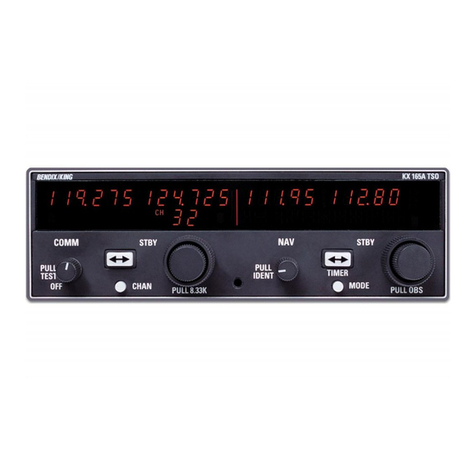
Honeywell
Honeywell Bendix KingSilver Crown Plus KX 155A manual

Yaesu
Yaesu FTDX-9000 Contest Brochure & specs
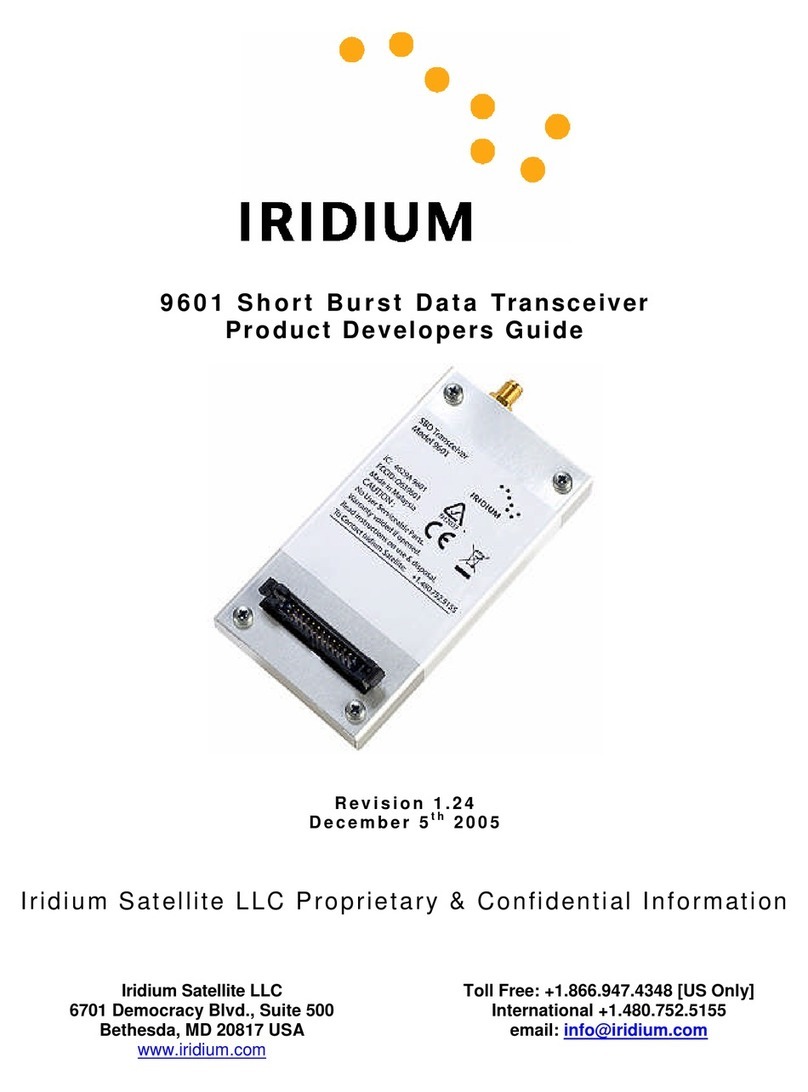
Iridium
Iridium 9601 Product Developer Guide


